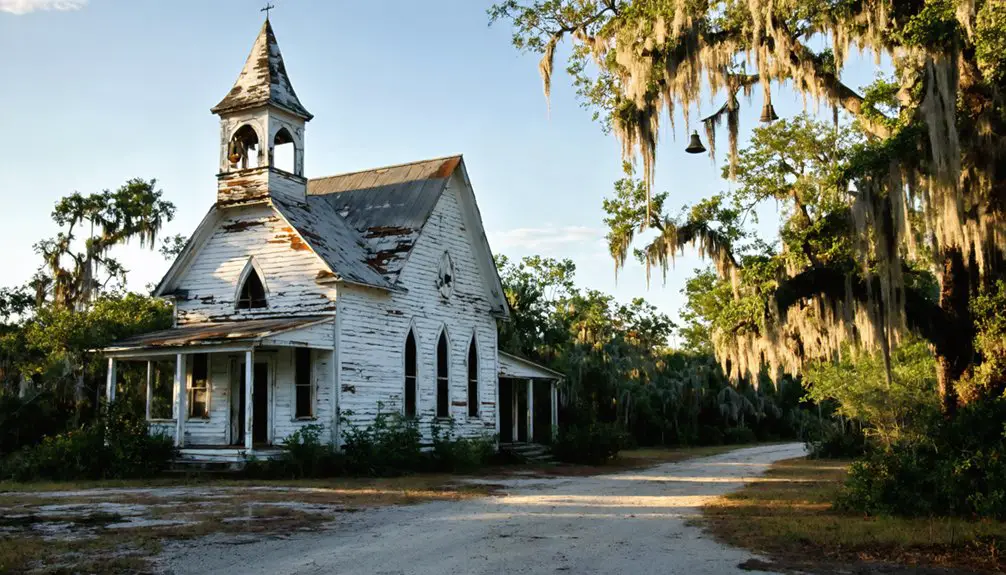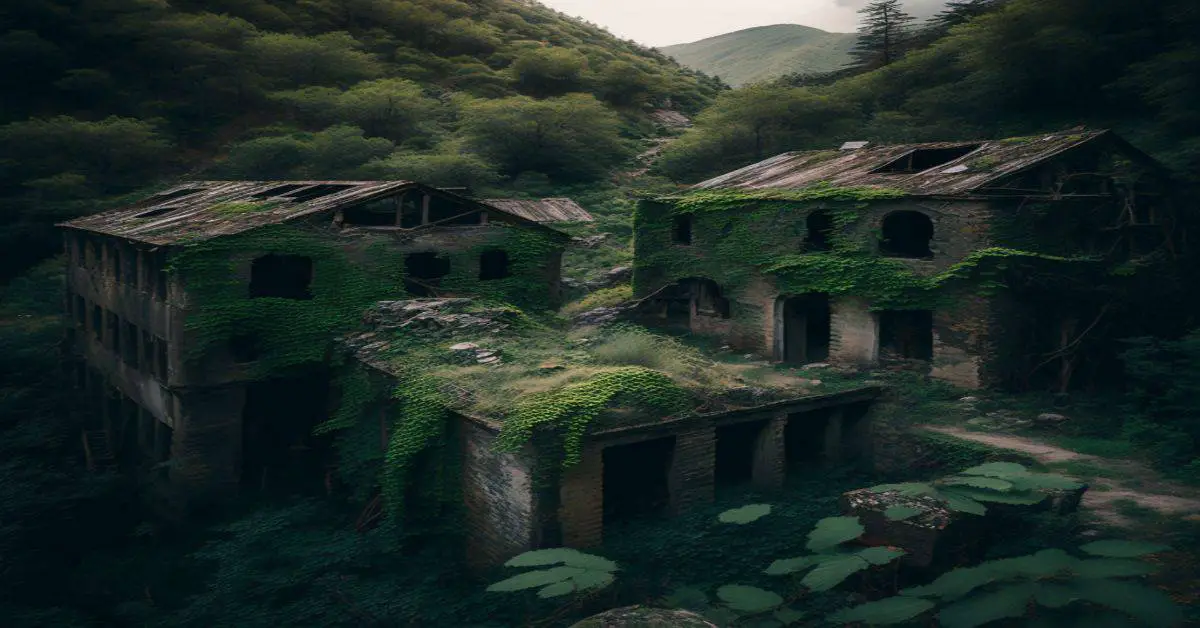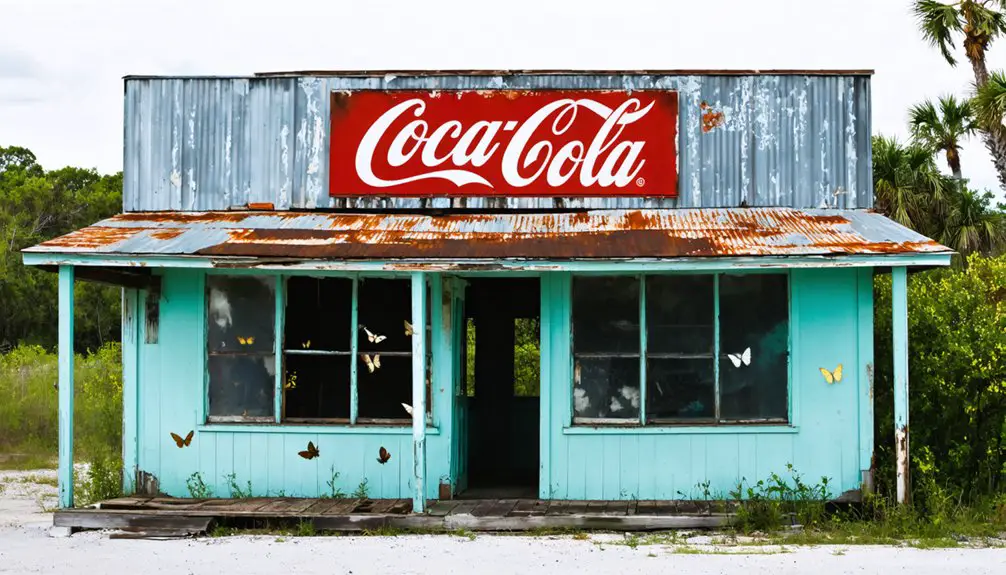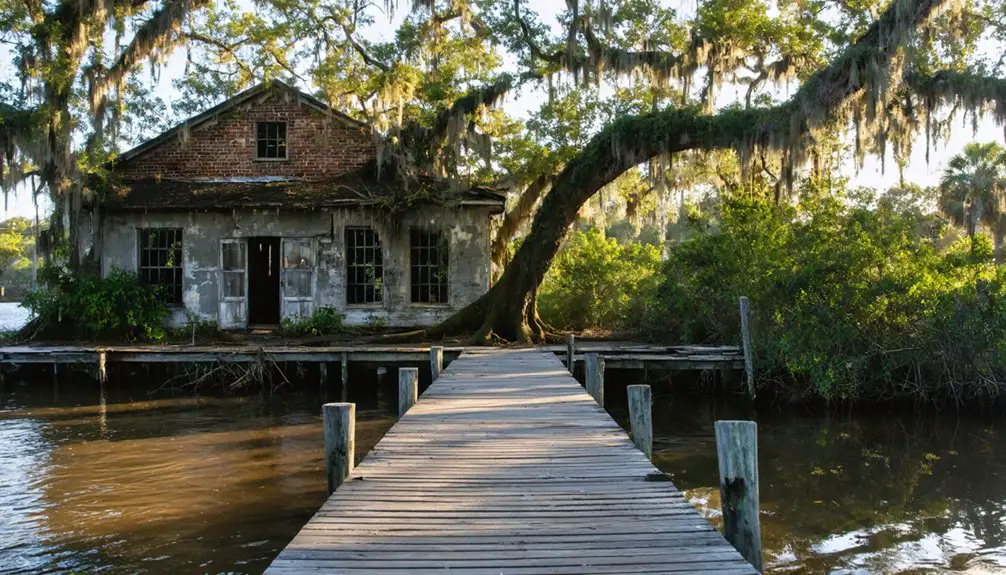You’ll discover Florida’s abandoned ghost towns scattered across the state, from military outposts like Fort Dade on Egmont Key to lost citrus communities like Eldora and Citra. These sites tell stories of the Great Freeze of 1894-95, yellow fever epidemics, and economic shifts that led to their decline. Nature now reclaims many locations, with remnants of sawmills, phosphate mines, and coastal settlements waiting to reveal their fascinating histories.
Key Takeaways
- Fort Dade on Egmont Key features abandoned military barracks, a lighthouse, and remnants of a once-thriving community of 600 residents.
- Eldora, located in Canaveral National Seashore, stands as a preserved ghost town showcasing Florida’s historic citrus industry decline.
- The town of Venus declined during the Great Depression, leaving behind concrete foundations now reclaimed by nature.
- St. Joseph, a former port city, was completely abandoned after a devastating yellow fever epidemic.
- Kerr City in Marion County remains one of Florida’s best-preserved ghost towns, accessible to visitors interested in historical exploration.
The Military Ghost Towns of Florida’s Past
While Florida’s military outposts once served as strategic defense points against Spanish invasions and Seminole conflicts, they’ve since transformed into some of the state’s most fascinating ghost towns.
You’ll find haunting remnants like Fort Dade on Egmont Key, where abandoned barracks and a lighthouse stand as silent witnesses to Florida’s military history.
In Venus, where two military trails once intersected, you can explore the concrete foundations of a lost settler community. The town flourished until the Great Depression caused its ultimate decline.
Settlement patterns typically followed a predictable path – first came the forts, then civilian communities with schools, churches, and commerce sprouted nearby.
When conflicts ended or disease struck, these outposts were often abandoned, leaving behind atmospheric ruins like those at Fort Kissimmee and the ghost town of Kicco.
The strategic outpost of Yukon met its end when it was bulldozed for expansion of a naval base during World War II.
Citrus Industry’s Lost Communities
Beyond Florida’s military outposts lies another chapter of abandoned settlements – the lost communities of the citrus industry.
You’ll find their remnants scattered across the state, where Spanish explorers first introduced citrus in 1493. Towns like Citra, Eldora, and Fairmount once thrived with banks, post offices, and packing houses, representing Florida’s rich citrus heritage.
The Great Freeze of 1894-95 marked the beginning of their decline, destroying countless groves and forcing pioneers to abandon their dreams. In Citra, farmers specialized in growing the unique hickory orange variety. Production plummeted from over 5 million boxes to just 150,000 boxes during this devastating period.
The brutal winter of 1894-95 shattered more than Florida’s citrus groves – it crushed the hopes of countless pioneering families.
While some communities survived initial freezes, later catastrophes in the 1980s dealt final blows. You can still trace this history through ghost towns like Eldora in Canaveral National Seashore, where economic decline followed devastating freezes.
The railroad’s decline and interstate development further isolated these communities, leaving only memories of Florida’s once-bustling citrus settlements.
Nature’s Reclamation of Abandoned Settlements
As decades pass, nature steadily reclaims Florida’s abandoned settlements, transforming man-made structures into wild habitats.
You’ll find vegetation and swamps overtaking old foundations, railroad lines, and building remnants, while tree roots progressively destabilize remaining structures. Nature’s takeover is particularly evident in former marshlands and floodplains, where wildlife now thrives among the ruins.
What you’re witnessing is ecological restoration in action. The old sawmill ruins reveal traces of a once-bustling town that produced lumber. Previously cleared paths have vanished beneath thick foliage, and soil erosion has buried many artifacts under layers of earth. The site where cypress logs floated in mill ponds has transformed into natural wetlands.
You’ll discover these ghost towns have become sanctuaries for local fauna, with birds, mammals, and reptiles making homes in the recaptured wilderness.
Protected preserves now safeguard these emerging ecosystems, balancing historical preservation with Florida’s natural heritage.
Hidden Coastal Ghost Towns Along Florida’s Shore
Hidden along Florida’s pristine coastline lie the remnants of once-vibrant communities that time has nearly forgotten.
You’ll discover hidden treasures like Fort Dade on Egmont Key, where over 600 residents once enjoyed amenities from tennis courts to theaters before abandonment left only brick roads and military ruins. Visitors today can explore the three major batteries that remain as silent sentinels of the fort’s military past.
Along Canaveral National Seashore, Eldora’s citrus-growing legacy ended with the devastating Great Freeze of 1895, while Oriole’s remains in Withlacoochee State Forest tell tales of a community felled by both freeze and influenza.
These fragments of coastal history now rest in protected areas, accessible mainly by boat or through parks.
While nature slowly reclaims these settlements, their preserved structures and interpretative sites offer glimpses into Florida’s maritime past, drawing visitors to explore their mysterious remains. The once-prosperous port city of St. Joseph vanished after a devastating yellow fever epidemic struck the bustling community.
Historic Industrial Sites Frozen in Time
Florida’s industrial heritage stands frozen in abandoned factories, foundries, and processing plants across the state.
You’ll discover industrial relics like Jacksonville’s Farris and Company Slaughterhouse, a 1921 facility that later became a cold storage warehouse before nature reclaimed it. The facility was designed by architect C.L. Brooks with solid brick construction and operated until a devastating fire in 1958.
The Florida Machine & Foundry Complex, dating to 1899, still showcases its historic rail siding, while the New Smyrna Sugar Mill ruins reflect early steam-powered industrialization efforts. Franklin Glazier Russell, Sr. acquired the foundry after relocating from Maine following the Great Fire of 1901.
In Medley, the transformed Pepper Steel & Alloys site demonstrates successful rehabilitation, now hosting thriving businesses.
The abandoned phosphate factory in Nichols holds particular historical significance with its intact 1880 steam locomotive, offering glimpses into Florida’s phosphate mining era.
These sites serve as evidence of the state’s evolving industrial landscape.
Exploring Florida’s Phosphate Mining Ghost Towns
Deep within Central Florida’s Bone Valley region, phosphate mining ghost towns like Nichols, Brewster, and Pierce stand as silent witnesses to the area’s rich industrial heritage.
These once-bustling communities, home to 400-800 residents each, formed the backbone of America’s phosphate history, producing 75% of the nation’s fertilizer by the 1920s.
You’ll find traces of a unique industrial past where company towns provided workers with everything from housing to hospitals.
Nichols, established in 1905, even offered both company housing and private residences – a rare setup for its time.
By the 1960s, though, improved transportation and changing company policies led to their decline.
Today, these abandoned mining communities rest largely off-limits on private land, their derelict buildings and faded roadways preserving snapshots of Florida’s industrial evolution.
Photography and Urban Exploration Opportunities
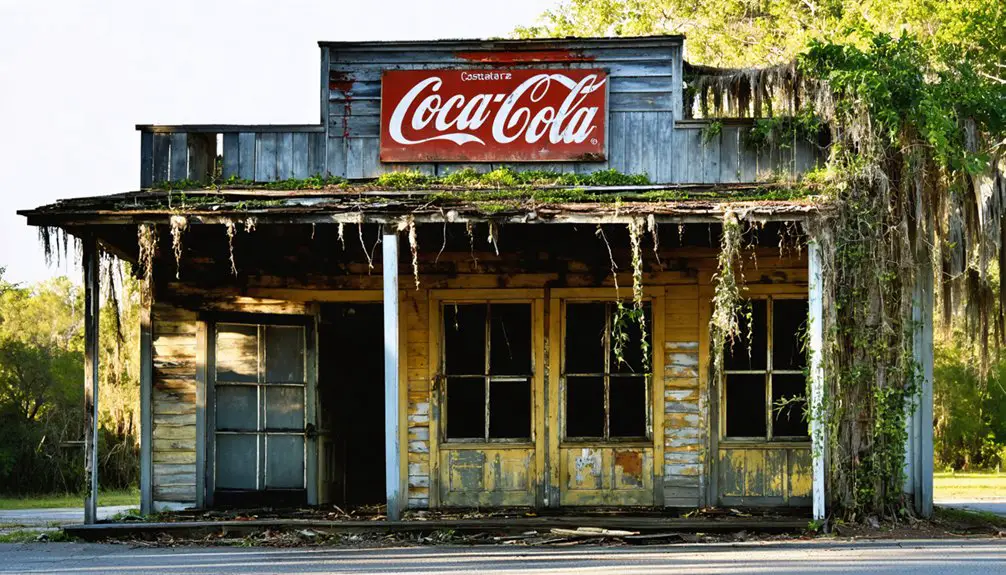
You’ll find Florida’s ghost towns most photogenic during winter (November-February) when reduced foliage reveals more structural details and cooler temperatures limit bug activity.
For capturing sites like Fort Dade or Hampton Springs, you’ll need a sturdy tripod, wide-angle lens (16-35mm), and weather-sealed camera body to handle coastal humidity and occasional rain.
Your essential gear should also include a powerful flashlight, knee pads for low-angle shots, and polarizing filters to manage harsh Florida sunlight while photographing weathered structures.
Best Photography Seasons
When planning to photograph Florida’s abandoned settlements, each season presents distinct opportunities and challenges for capturing these haunting remnants of the past.
Winter’s cooler, drier weather offers ideal conditions with clear skies and reduced insect activity, perfect for exploring sites like Fort Dade and Eldora.
Spring brings vibrant flora that contrasts beautifully with weathered structures, enhancing ghost town aesthetics through natural frames and textures.
You’ll want to avoid summer’s harsh midday sun and frequent thunderstorms by shooting during golden hours.
Fall provides the sweet spot for seasonal photography with soft light, comfortable temperatures, and fewer tourists.
The November-April dry season also guarantees easier access to remote locations, while stable weather patterns allow for reliable boat transportation to island ghost towns like Egmont Key.
Equipment For Ghost Exploration
Successful ghost town photography in Florida requires three essential categories of equipment: imaging gear, safety equipment, and specialized accessories.
For your camera setup, you’ll need a DSLR or mirrorless camera with wide-angle and prime lenses to capture both sweeping architectural views and detailed artifacts. Pack a sturdy tripod for low-light shots and remote triggers for shake-free exposures.
Essential gear includes weather-resistant camera bags to protect against Florida’s humidity and sudden storms.
Safety precautions are critical in the state’s unstable abandoned structures. You’ll want reliable headlamps, sturdy boots with good grip for traversing deteriorating buildings, and protective clothing.
Don’t forget your GPS device and fully charged phone – Florida’s dense vegetation can make navigation tricky. Remember to pack lens cleaning supplies, as the state’s sandy soil tends to coat equipment quickly.
Best-Preserved Ghost Town Sites for Visitors
Florida’s best-preserved ghost towns offer visitors tangible connections to the state’s fascinating past, from abandoned military outposts to forgotten citrus communities.
You’ll discover remarkably intact sites that showcase the state’s diverse history of settlement and abandonment, with ghost town preservation efforts making these locations accessible for memorable visitor experiences.
- Fort Dade on Egmont Key beckons with its crumbling military structures and lighthouse, especially atmospheric during sunset hours.
- Eldora’s restored house within Canaveral National Seashore stands as a monument to the devastating Great Freeze of 1895.
- Centralia’s concrete sawmill remnants in Chassahowitzka reveal the legacy of Florida’s lumber industry.
- Kerr City in Marion County maintains its historical buildings, offering an authentic glimpse into early Florida settlement life.
Frequently Asked Questions
Are There Any Reported Ghost Sightings in Florida’s Abandoned Towns?
You’ll find haunted legends throughout Florida’s abandoned towns, with spectral sightings reported at Fort Dade’s military ruins, Hampton Springs’ old hotel, and Fort Drum’s cemetery, though scientific proof remains elusive.
Can You Legally Collect Artifacts From Florida Ghost Town Sites?
You can’t legally snatch those tempting artifacts without proper permits! Legal regulations require permission from landowners, state agencies, or federal authorities – and artifact preservation laws mean heavy penalties for unauthorized collection.
Which Ghost Towns Are Accessible Without Special Permits or Guides?
You’ll find accessible locations at Egmont Key, Eldora, The Place at Alafaya, and Otter Creek – each offering unique ghost town history you can freely explore without permits or mandatory guides.
Do Any Florida Ghost Towns Still Have Active Cemeteries?
You’ll find active burial sites in several Florida ghost towns, especially where churches still operate. Markham’s Pinnie Ridge Cemetery and Orleans’ historic cemetery preservation efforts show continuing community connections despite town abandonment.
What Survival Gear Is Recommended for Exploring Remote Ghost Towns?
You’ll need survival kits with water filters, first-aid supplies, navigation tools, plus exploration tools like sturdy boots, gloves, flashlights, dust masks, and protective clothing for potentially hazardous abandoned structures.
References
- https://patchproflorida.com/blog/the-fascinating-history-of-floridas-ghost-towns/
- https://www.ghosttowns.com/states/fl/fl.html
- https://en.wikipedia.org/wiki/List_of_ghost_towns_in_Florida
- https://www.youtube.com/watch?v=bNjqcQ5SMwg
- https://www.findmall.com/threads/florida-ghost-towns.302434/
- https://historicarchaeology.weebly.com/journal/venus-in-florida-ghost-town-101
- https://www.legendsofamerica.com/fort-kissimmee-florida/
- https://www.worldatlas.com/travel-stories/north-florida-s-infamous-ghost-town.html
- https://www.youtube.com/watch?v=lpufNDdM_mY
- http://www.desolationflorida.com/2016/08/citra.html
